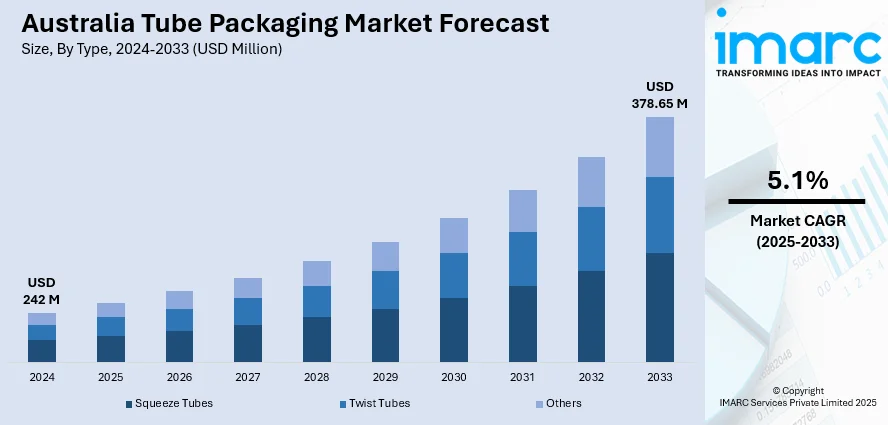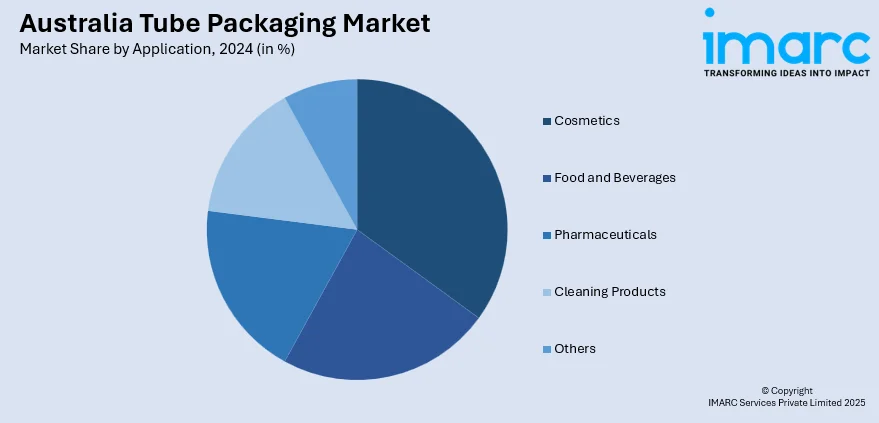
Australia Tube Packaging Market Size, Share, Trends and Forecast by Type, Material Type, Application, and Region, 2025-2033
Australia Tube Packaging Market Overview:
The Australia tube packaging market size reached USD 242 Million in 2024. Looking forward, IMARC Group expects the market to reach USD 378.65 Million by 2033, exhibiting a growth rate (CAGR) of 5.1% during 2025-2033. Growing demand for convenient, travel-friendly personal care and cosmetic products, sustainability focus driving adoption of recyclable aluminum and plastic tubes, rising pharmaceutical packaging needs, innovation in tube barrier technologies, and increasing preference for premium, visually appealing packaging formats are some of the factors contributing to Australia tube packaging market share.
|
Report Attribute
|
Key Statistics
|
|---|---|
|
Base Year
|
2024
|
|
Forecast Years
|
2025-2033
|
|
Historical Years
|
2019-2024
|
| Market Size in 2024 | USD 242 Million |
| Market Forecast in 2033 | USD 378.65 Million |
| Market Growth Rate 2025-2033 | 5.1% |
Australia Tube Packaging Market Trends:
Sustainable Packaging Gaining Ground in Personal Care
The tube packaging sector in Australia is seeing rising adoption of aluminum formats, especially among personal care brands aiming to reduce environmental impact. Lightweight, recyclable, and offering a premium feel, aluminum tubes are increasingly favored for skincare and cosmetic applications. Their compatibility with antioxidant-rich formulations and global appeal positions them as a smart packaging choice for brands seeking expansion abroad. The growing alignment with eco-conscious packaging across international markets is pushing Australian companies to adopt materials that meet both aesthetic and sustainability benchmarks. This shift is driven by evolving consumer preferences and regulatory focus on greener solutions in beauty and wellness products. Aluminum’s appeal lies not just in recyclability but also in its role in enhancing brand perception and shelf presence. These factors are intensifying the Australia tube packaging market growth. For example, in April 2025, Australian skincare brand Vincent entered the US market with its antioxidant-rich, apple-based product line packaged in aluminum tubes. The use of aluminum reflects a shift in the Australian tube packaging market toward eco-conscious solutions, aligning with global sustainability trends in personal care. This move highlights rising international demand for recyclable, premium packaging formats from Australian brands.

To get more information on this market, Request Sample
Growing Shift toward Fully Recyclable Tube Materials
The market is witnessing a stronger preference for high-density polyethylene (HDPE) tubes that can be processed through existing curbside recycling systems. As environmental concerns continue to shape packaging choices, brands are increasingly moving toward formats that align with recyclability standards without compromising product protection or usability. HDPE’s widespread acceptance in local recycling infrastructures makes it a practical alternative to traditional laminated tubes, which are harder to process. This movement reflects an industry-wide push to harmonize packaging with circular economy goals. In Australia, the momentum is particularly visible across oral care and personal hygiene categories, where consumers and retailers alike are showing increased support for packaging solutions that demonstrate long-term environmental responsibility and compliance with upcoming regulatory expectations. For instance, in April 2023, Colgate-Palmolive transitioned all toothpaste tubes to recyclable HDPE formats, aiming for full recyclability across its global portfolio by 2025. This shift is relevant to the Australian tube packaging market, where demand for sustainable and curbside-recyclable solutions is rising. The move underscores a broader industry trend toward eco-friendly materials influencing packaging practices in Australia.
Australia Tube Packaging Market Segmentation:
IMARC Group provides an analysis of the key trends in each segment of the market, along with forecasts at the country and regional levels for 2025-2033. Our report has categorized the market based on type, material type, and application.
Type Insights:
- Squeeze Tubes
- Twist Tubes
- Others
The report has provided a detailed breakup and analysis of the market based on the type. This includes squeeze tubes, twist tubes, and others.
Material Type Insights:
- Plastics
- Paper
- Aluminum
- Others
A detailed breakup and analysis of the market based on the material type have also been provided in the report. This includes plastics, paper, aluminum, and others.
Application Insights:

- Cosmetics
- Food and Beverages
- Pharmaceuticals
- Cleaning Products
- Others
A detailed breakup and analysis of the market based on the application have also been provided in the report. This includes cosmetics, food and beverages, pharmaceuticals, cleaning products, and others.
Regional Insights:
- Australia Capital Territory & New South Wales
- Victoria & Tasmania
- Queensland
- Northern Territory & Southern Australia
- Western Australia
The report has also provided a comprehensive analysis of all the major regional markets, which include Australia Capital Territory & New South Wales, Victoria & Tasmania, Queensland, Northern Territory & Southern Australia, and Western Australia.
Competitive Landscape:
The market research report has also provided a comprehensive analysis of the competitive landscape. Competitive analysis such as market structure, key player positioning, top winning strategies, competitive dashboard, and company evaluation quadrant has been covered in the report. Also, detailed profiles of all major companies have been provided.
Australia Tube Packaging Market News:
- In April 2024, John Paul Mitchell Systems revamped its Tea Tree line with sustainability-focused packaging. Bottles and jars now use 100% post-consumer recycled (PCR) plastic, while tubes incorporate 25% PCR. The brand also introduced reusable aluminum bottles and refill pouches made with 75% less plastic. These changes align with the company's commitment to reducing virgin plastic usage and enhancing eco-friendly practices in the packaging industry.
Australia Tube Packaging Market Report Coverage:
| Report Features | Details |
|---|---|
| Base Year of the Analysis | 2024 |
| Historical Period | 2019-2024 |
| Forecast Period | 2025-2033 |
| Units | Million USD |
| Scope of the Report |
Exploration of Historical Trends and Market Outlook, Industry Catalysts and Challenges, Segment-Wise Historical and Future Market Assessment:
|
| Types Covered | Squeeze Tubes, Twist Tubes, Others |
| Material Types Covered | Plastics, Paper, Aluminum, Others |
| Applications Covered | Cosmetics, Food and Beverages, Pharmaceuticals, Cleaning Products, Others |
| Regions Covered | Australia Capital Territory & New South Wales, Victoria & Tasmania, Queensland, Northern Territory & Southern Australia, Western Australia |
| Customization Scope | 10% Free Customization |
| Post-Sale Analyst Support | 10-12 Weeks |
| Delivery Format | PDF and Excel through Email (We can also provide the editable version of the report in PPT/Word format on special request) |
Key Questions Answered in This Report:
- How has the Australia tube packaging market performed so far and how will it perform in the coming years?
- What is the breakup of the Australia tube packaging market on the basis of type?
- What is the breakup of the Australia tube packaging market on the basis of material type?
- What is the breakup of the Australia tube packaging market on the basis of application?
- What is the breakup of the Australia tube packaging market on the basis of region?
- What are the various stages in the value chain of the Australia tube packaging market?
- What are the key driving factors and challenges in the Australia tube packaging?
- What is the structure of the Australia tube packaging market and who are the key players?
- What is the degree of competition in the Australia tube packaging market?
Key Benefits for Stakeholders:
- IMARC’s industry report offers a comprehensive quantitative analysis of various market segments, historical and current market trends, market forecasts, and dynamics of the Australia tube packaging market from 2019-2033.
- The research report provides the latest information on the market drivers, challenges, and opportunities in the Australia tube packaging market.
- Porter's five forces analysis assist stakeholders in assessing the impact of new entrants, competitive rivalry, supplier power, buyer power, and the threat of substitution. It helps stakeholders to analyze the level of competition within the Australia tube packaging industry and its attractiveness.
- Competitive landscape allows stakeholders to understand their competitive environment and provides an insight into the current positions of key players in the market.
Need more help?
- Speak to our experienced analysts for insights on the current market scenarios.
- Include additional segments and countries to customize the report as per your requirement.
- Gain an unparalleled competitive advantage in your domain by understanding how to utilize the report and positively impacting your operations and revenue.
- For further assistance, please connect with our analysts.
 Request Customization
Request Customization
 Speak to an Analyst
Speak to an Analyst
 Request Brochure
Request Brochure
 Inquire Before Buying
Inquire Before Buying




.webp)




.webp)












